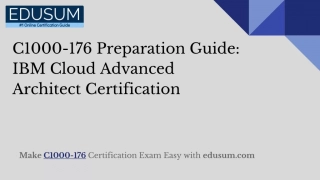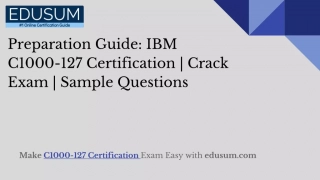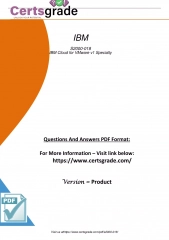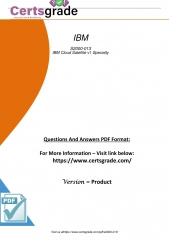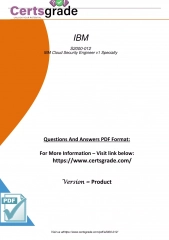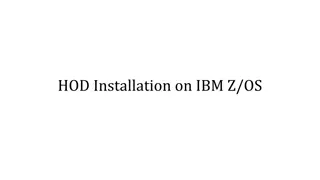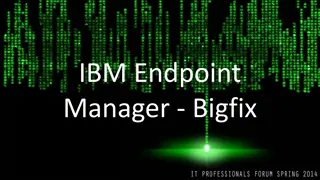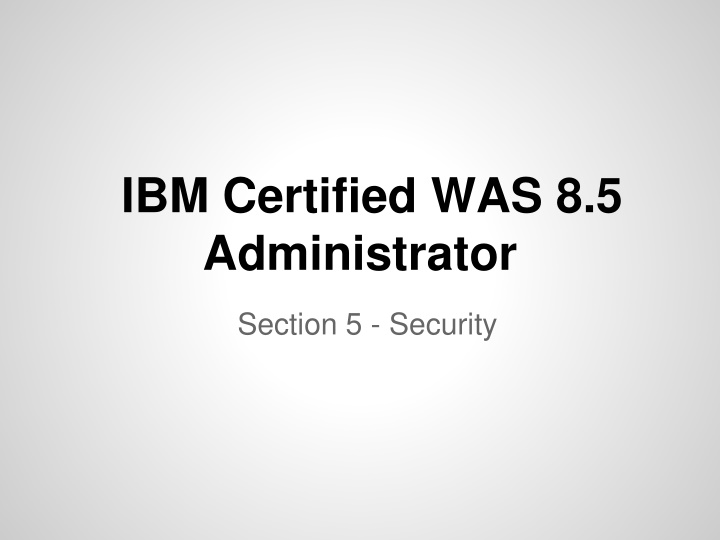
IBM Certified WAS 8.5 Administrator Section 5 - Security Overview
Explore the comprehensive Security Overview of IBM Certified WAS 8.5 Administrator Section 5, covering Administrative Security, Application Security, Java 2 Security, Administrative Roles, Application Level Security, Authentication, and User Registries for enhanced security measures in WebSphere Application Server environments.
Download Presentation

Please find below an Image/Link to download the presentation.
The content on the website is provided AS IS for your information and personal use only. It may not be sold, licensed, or shared on other websites without obtaining consent from the author. If you encounter any issues during the download, it is possible that the publisher has removed the file from their server.
You are allowed to download the files provided on this website for personal or commercial use, subject to the condition that they are used lawfully. All files are the property of their respective owners.
The content on the website is provided AS IS for your information and personal use only. It may not be sold, licensed, or shared on other websites without obtaining consent from the author.
E N D
Presentation Transcript
IBM Certified WAS 8.5 Administrator Section 5 - Security
Security Overview Three types: Administrative Security Application Security Java 2 Security
Administrative Security Controls access to Admin functions (such as logging on to Admin Console and wsadmin) Administrative roles for defining access level Fine grained access possible (you can configure to have access only to certain application servers) Administrative security must be enabled to enable Application Security Enabling Administrative Security enables usage of SSL
Various Administrative roles Monitor: View state of the environment Configurator: Monitor + config changes Operator: Monitor + start/stop processes Administrator: Everything iscadmins: Admin rights for managing users/groups in admin console ONLY Deployer: Configure,start/stop applications Admin Security Manager: Manage user/group/roles Auditor: Configure Auditing subsystem
Application Security and Java 2 Security Controls Application Level Security such as accessing certain parts of the application Developer develops with roles in mind At deploy time, roles get mapped to groups or users by the Deployer Security constraints in deployment descriptors control access to servlets Method permissions in deployment descriptor control access to EJBs Java 2 security restrict access to local resources such as files and Sockets using policy files
Authentication Authentication is the first step in the security flow (followed by authorization) Authentication mechanism defined in the Application deployment descriptor Basic, Form based and certificate based Basic authentication forces the user to enter username/password. Weak encoding
User Registries Authentication process requires a user registry to validate username and password Supported: Local OS (including Domain in Windows),Standalone LDAP, Custom, Federated
Configuring Security You can use Security Configuration Wizard from Admin console or do it manually You will need username/password for most types of repositories (ex: Standalone LDAP bind credentials) Custom registries required the custom classes to be available to WAS when configuring WAS provides com.ibm.websphere.security.FileRegistrySa mple
LTPA Is the mechanism used to handle authentication Token can be forwarded (LTPA delegation)
LTPA Cont For Single Sign on across cell, the keyfile needs to be exported in one cell and imported in another
Authorization After authentication, WAS needs to authorize a user for the requested operation/resource Authorization is done using roles
SSL Basics SSL (Secure Sockets Layer) provides Data protection and Integrity) between Server and Client Uses Asymmetric cryptography (Public and Private key). Shared secret key is established and is unique for each session (short lived) Various Cipher Suites supported (highest version common to Client and Server is always chosen)
Keystores WAS manages SSL certificates in keystores ikeyman tool or WAS Admin Console can be used to manage keystores Personal Certificates (Server certificates) are stored in KeyStore. CA Certificates are stored in TrustStore. By default, each Node gets a System generated Node personal certificate and Node Signer certificate. All Node Signer certificates are stored in CellDefaultTrustStore and distributed to all Nodes
Keystores Cont... In practice you will install a CA signed personal certificate Application Servers, by default will use the certificates from NodeDefaultKeystores Keystores are organized using SSL Configurations CellDefaultSSLSettings and NodeDefaultSSLSettings are the default WebServers use CMS keystores and Application Servers use IBMJCE based PKCS12 keystores
Requesting and installing SSL Personal Certificate First create CSR (Certificate Signing Request) providing the Common Name and other information Submit CSR to a CA (certificate authority) and receive the personal certificate and signer certificate Receive certificate from a certificate authority Ensure the singer certificate is added to the trust store
Security Auditing Reports auditable events to ensure integrity Authentication Authorization Principal/Credential Mapping Audit policy management Delegation Enabled using the check box Enable Auditing under Security -> Security Auditing in WAS Admin Console New event filters in addition to the default ones can be configured at Security -> Security Auditing -> Event type filters
Security Auditing Cont... Audit records can be encrypted and/or digitally signed for protection Audit Reader utility reads the binary audit log and produces HTML report Audit reader utility can ONLY be invoked via wsadmin AdminTask.binaryAuditLogReader You can also view the Audit log file via a text editor, but can be difficult to read
Security Domains Security configuration at multiple levels (i.e Cell, Application Server etc) Cell level Security domain is the default New security domains can be created with attributes such as User registry , Java 2 security with different values The new security domain can be assigned to Cluster, Server or Service Integration Bus

